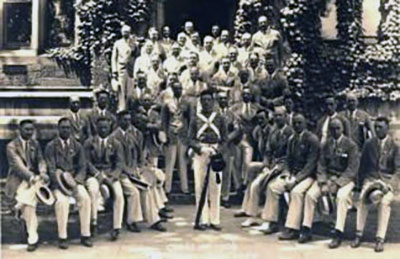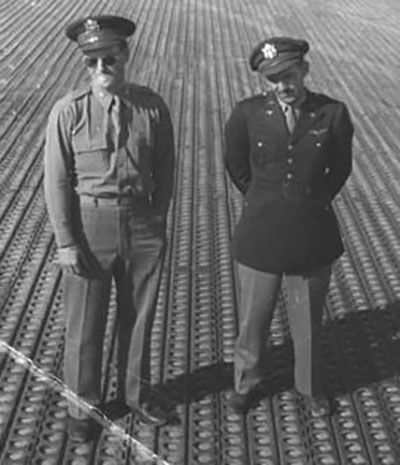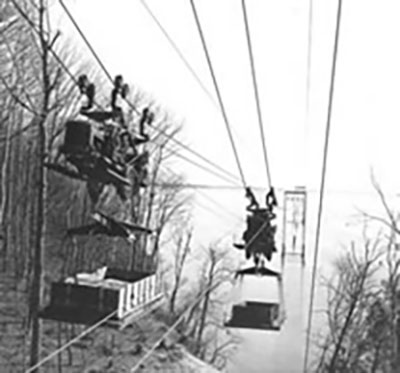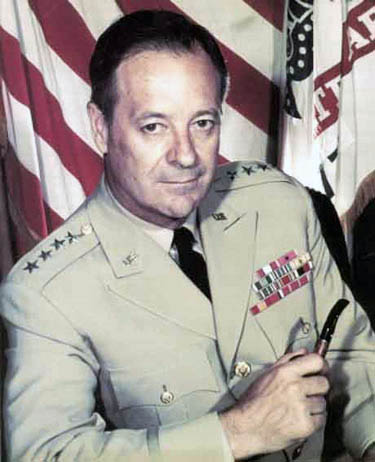


Frank Schaffer Besson, Jr. was born on May 30, 1910 in Detroit Michigan to father, Frank Schaffer Besson and mother, Virginia Koehler Besson.
Besson graduated from the United States Military Academy, West Point in 1932 in the top ten of his class. He was presented an Officer's saber upon graduation, by the class of 1909.
In 1940, First Lieutenant Besson was assigned to the Engineer Board at Fort Belvoir, Virginia, where he developed new equipment for the support of combat operations. One of his developments was the Pierced Steel Planking (PSP).
Chief of the Army Air Corps, General H.H. "Hap" Arnold was looking for an airfield that could be built in one day, accommodate his heaviest bombers, and easily camouflaged.
The PSP was the answer to this need. It was manufactured in 2' x 8' sheets that hooked to each other, grass grew through the holes of each sheet, making the runway camouflaged from the air, and was strong enough to accommodate the heavy bombers.

As a lieutenant colonel in 1943, Besson was assigned as Assistant Director and General Manager of the Third Military Railway Service in Iran, assuming full command in 1944. His mission was to manage the Iranian State Railroad in getting U.S. supplies to Russia. The railroad was a single track road, winding 1,000 miles from the Persian Gulf to the Iranian-Russian border on the Caspian Sea.
Despite language barriers, environmental conditions and other difficulties, the railroad surpassed all previous performance records. Under his command, more than five million tons of essential war materials were delivered to the Russian Army to help repel the German attack. He was awarded the Army Legion of Merit for his outstanding work. The Shah of Iran personally presented him with the Iranian Medal, the Order of Hoymanoun, Second Class.
Besson was promoted in early 1945 to Brigadier General, becoming the youngest brigadier general in the ground forces of World War II
After V-E Day in May 1945, Brigade General Besson was assigned as Deputy Chief Transportation Officer of the Western Pacific and assumed total control of the railroads in the Eighth Army's assigned zone of occupation. Incoming occupation troops were soon moving throughout northern Japan by rail from shipside to airport.
From 1946-1948, BG Besson was assigned by MacArthur as Director of the Civil Transportation Division, Supreme Headquarters, Allied Powers in Japan. He was responsible for all military water, motor and rail transportation activities in Japan, the Philippines, the Marianas, and Korea.

Among his accomplishments was the establishment of a "depot on wheels," storing 20,000 rail cars worth of valuable military equipment, released by inactivated units. Saved from deterioration, the equipment was later rehabilitated, following soon after, played an important part during the Korean campaign. BG Besson returned to the U.S. in 1948 and served nearly five years as Deputy Chief of Army Transportation.
Besson was promoted to Major General in 1950, and assumed command of the U.S. Army Transportation Center and School at Fort Eustis in 1953.
He directed extensive studies to develop new doctrines that would enable the Corps to better cope with the requirements of modern warfare. His vision involved the routine, rather than the emergency, use of air transportation, employment of express surface transport, full exploitation of special purpose containers, vehicles, material handling equipment and ships of radical design.
He pioneered many concepts aimed at improving the speed and efficiency into the transportation system by using containerization, roll-on/roll-off vessels, and improved amphibious vessels, such as the 5-ton and 15-ton LARC's and the 60-ton BARC.
From 1958 to 1962, Besson served as the Chief of Army Transportation. Besson was then promoted to Lieutenant General in 1962, and became the first chief of the U.S. Army Material Command (AMC).

AMC represented a major reorganization within the Army, consolidating all seven technical services. Many consider his role in helping establish the AMC, and his six years of service as its first commander, as his most important contribution to the Army.
In 1964, Frank S. Besson, Jr. became the 75th officer in the Army's 189-year history to become a four star general.
He was the first Transportation Corps officer to achieve that rank and also the first to achieve the rank as head of a logistical organization in peacetime.
After retirement in 1969, General Besson was recalled to serve as Chairman of the Joint Logistics Review Board, reporting on worldwide logistic support to U.S. forces during the Vietnam conflict. In 1970, he was appointed by President Nixon as a founding director and first CEO of the National Rail Passenger Corporation, the operators of AMTRAK.
He was founder and Director of the Board of Services National Bank of Alexandria, Virginia, and a member of the Board of Directors of the Environmental Research Corporation of Fairfax County, Virginia.
General Besson retired in 1970 after more than 37 years of commissioned service, 25 of them as a general officer. He received many U.S. and foreign awards and decorations, including the Distinguished Service Medal with two Oak Leaf Clusters, the Legion of Merit with one Oak Leaf Cluster, the Iranian Order of Homayoun Star, Commander of the Order of the British Empire, and the Republic of Korea's Order of the Military Merit, Second Class (Ulchi).